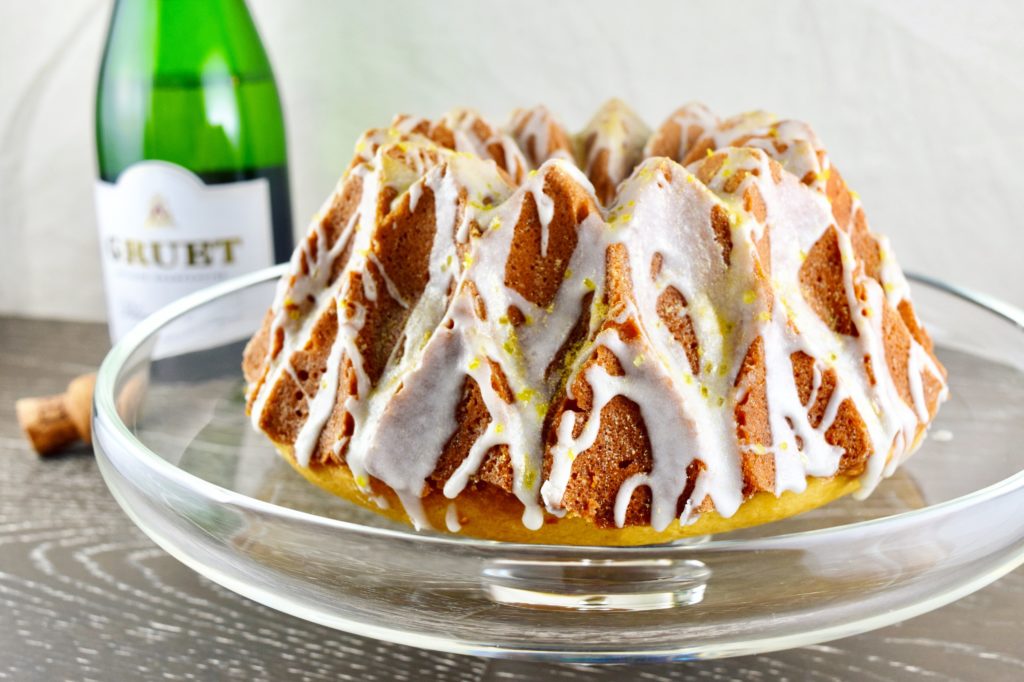Champagne Buttermilk Bundt Cake

Prep time
Cook time
Total time
Author: Good Health Gourmet
Yield: One 10-inch bundt cake
Ingredients
- For the Cake
- 224 grams (2 sticks) unsalted butter, softened
- 300 grams (1 ½ cups) granulated sugar
- 420 grams (about 3 cups) GF all-purpose flour, plus more for the pan
- ¼ teaspoon baking soda
- ½ teaspoon baking powder
- ½ teaspoon salt
- 120 ml (½ cup) shaken buttermilk
- 150 ml (½ cup + 2 tablespoons) champagne*
- 3 large eggs
- For the Syrup
- 30 ml (2 tablespoons) water
- 26 grams (2 tablespoons) granulated sugar
- 30 ml (2 tablespoons) champagne
- For the Glaze
- 192 grams (1 ½ cups) confectioners' sugar, sifted
- 45 ml (3 tablespoons) champagne
- 10 grams (2 teaspoons) unsalted butter, melted
- Optional garnish: sparkling sugar, luster dust or gold leaf
Procedure
- Preheat oven to 325°F and set an oven rack in the middle position. Generously grease a 10-inch bundt pan and set aside. Place a cooling rack on/inside a sheet pan and set aside.
- Make the batter: In the bowl of an electric mixer fitted with paddle attachment (or hand mixer with beaters), cream butter and sugar on medium speed until light and fluffy, 3-4 minutes.
- Meanwhile in a medium bowl, sift together the flour, baking soda, baking powder and salt. Set aside. Combine the buttermilk and champagne in a liquid measuring cup and set that aside as well.
- Once the butter and sugar mixture is light and fluffy, scrape down the sides of the mixing bowl and beat in the eggs one at a time, mixing well after each addition. Scrape down the sides of the bowl again. With the mixer running on low speed, beat in ⅓ of the flour mixture, then ⅓ of buttermilk/champagne mixture. Repeat with remaining flour & buttermilk, then beat on medium-high for about 20-30 seconds until silky and uniform, stopping the mixer once to scrape down the sides if necessary.
- Bake the cake: The batter will be very thick. Spoon it into the prepared pan and smooth out the top with rubber spatula, pressing firmly to ensure there are no gaps in the batter. Bang the pan (or drop it from 2-3 inches high) on the counter several times to knock out any trapped air.
- Bake for 1 hour, or until the top is cracked and barely golden and a cake tester comes out clean, rotating the pan 180 degrees about halfway through baking. Cool the cake in the pan for ten minutes on a rack.
- Make the syrup: Combine the water and sugar in a saucepan and bring to a boil, whisking to dissolve sugar. Remove from heat and stir in champagne.
- Soak the cake: Set the cooling rack inside a sheet pan, and invert the warm cake onto the rack. Using a pastry brush, dab the warm syrup all over the cake, letting it soak in. A little syrup will drip off, but try not to rush so that most of it is absorbed. Allow the cake to cool completely, at least one hour.
- Glaze the cake: Once the cake is cool, make the glaze: Combine the ingredients in a medium bowl, mixing vigorously with a fork or whisk until smooth. Add more confectioners' sugar or champagne as necessary to make a thick but pourable glaze (it should be the consistency of honey). Spoon or drizzle the glaze over the top of the cake in whatever decorative pattern you desire. After glazing, feel free to add other garnishes such as sparkling sugar, luster dust or gold leaf.
Notes
*You can use any type of champagne or sparkling wine for this cake - brut, prosecco, sparkling rosé - whatever your heart and palate desire. I happen to love drinking the blanc de blancs style of champagne, so that's what I use. This style of bubbly can be a bit pricy, so you'll see in some of the photos that I've featured one of the more affordable options - the blanc de blancs from an American winery called Gruet.
Recipe by Good Health Gourmet at https://goodhealthgourmet.com/champagne-buttermilk-bundt-cake/